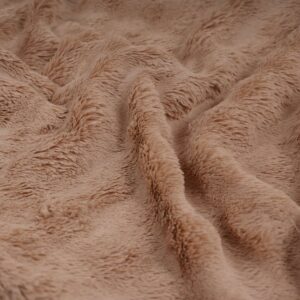Faux fur fabric turned into a major conversation in the fashion and textile circles. At first, pushed to the side as nothing more than a low-quality replacement for real animal fur, it is now well-praised due to its usefulness, ethical making, and flexibility across many fields. From high-end coats and throws to furniture coverings and even car inside designs, fake fur material has grown into something that holds both practical use and visual appeal.
The key question many consumers ask is: Is faux fur fabric actually a good material? To answer this thoroughly, we need to explore its composition, benefits, drawbacks, performance compared to real fur, and the range of applications where it shines. This article provides a deep dive into these aspects, giving a complete perspective for buyers, designers, and industry professionals.
What is faux fur fabric?
Faux fur fabric is sometimes referred to as artificial fur or fake fur. It is a man-made fabric created to resemble the appearance and texture of actual animal skin. Real fur comes from animals, but faux fur mainly consists of synthetic materials like polyester, acrylic, or modacrylic-typically obtained separately Then these fibers are attached to supporting material and undergo treatment so that a thick pile surface resembling the softness and bulkiness typical for regular fur is achieved.
Faux fur fabric was created to give a pain-free choice, but now it does much more. It has turned into a top fabric group that mixes moral thought with tech gains, giving designers and buyers a material they can get easily that seems rich without the ethical and green worries linked to goods from animals.
The Evolution of Faux Fur Fabric
The Evolution of Faux Fur In the early 20th century, faux fur was introduced as a cheaper alternative to fur coats. Earlier versions were not just less realistic but also less durable. They looked very artificial with a plasticky sheen and did not resist wear well.
Jump to the modern day, and technological innovation has greatly changed faux fur. Better fiber engineering, advanced weaving methods, and dyeing techniques let manufacturers create highly realistic textures. Faux fur now offers countless colors, pile lengths, and patterns many of which come very close to looking just like real fur. This evolution has raised faux fur fabric to a serious competitor in the global textile market particularly when it comes to fashion as well as upholstery and interior design.
Advantages of Faux Fur Fabric
When evaluating whether faux fur fabric is a good material, it is essential to look at its strengths.
- Ethical and Cruelty-Free
The most obvious benefit is its animal-friendly production. No animals are harmed to create faux fur, making it a preferred choice for ethically conscious consumers and brands. This aligns with the growing demand for sustainable and cruelty-free fashion.
- Wide Range of Styles
Faux fur can be designed in multiple pile lengths, densities, and colors. It can replicate the look of mink, fox, rabbit, or even exotic furs at a fraction of the cost. Custom dyeing makes it possible to match any design palette, from natural tones to bold fashion-forward hues.
- Durability
Unlike real fur, faux fur is not as sensitive to humidity, sunlight, or insects. With proper care, a high-quality faux fur garment or fabric can last many years without shedding excessively or deteriorating.
- Lower Cost
Genuine fur comes with high production and procurement costs. Faux fur provides a luxurious aesthetic at a more affordable price point, making it accessible to a wider audience.
- Versatility of Use
Faux fur is not restricted to apparel. It is also widely used in home décor (throws, cushions, rugs), furniture upholstery, handbags, and even in stage costumes for film and theater.
- Hypoallergenic Qualities
Some people are allergic to natural animal fur. Faux fur, being synthetic, generally causes fewer allergic reactions.
Faux Fur vs. Real Fur
A meaningful analysis of faux fur must compare it with its natural counterpart.
| Feature | Faux Fur Fabric | Real Fur |
| Ethical Aspect | Cruelty-free, animal-friendly | Requires animal harvesting |
| Cost | Generally affordable | Very expensive |
| Durability | Resistant to moths, easier care | Needs special preservation |
| Variety | Customizable colors and patterns | Limited to natural shades |
| Breathability | Less breathable | Natural insulation and airflow |
| Environmental Impact | Petroleum-based, non-biodegradable | Ethical issues, but biodegradable |
From this comparison, faux fur stands out for ethics, versatility, and affordability, while real fur still has advantages in breathability and natural insulation.
Applications of Faux Fur Fabric
- Fashion Wear
Coats, jackets, vests, trims, and hats largely embrace faux fur as the fashionable yet inexpensive option. Luxury brands intake high-end collections with faux fur to express its fashion credentials.
- Home Furnishing
Blankets, cushions, and rugs add warmth plus luxury into the home interior space. They are warmly welcomed in the interior design due to their cozy look.
- Furniture Upholstery
Seats and stools clothed in fake fur have found love in the current decor, more so in chic and Scandinavian-inspired looks.
- Car Inside Looks
Fake fur sometimes finds its place in seat covers, steering wheel wraps, and decorative trims giving both comfort and looks to the eye.
- Play and Dress
Design For film, stage, and cosplay, fake fur is of great worth due to its flexibility and low cost.
Environmental Considerations
Sustainability counts as one of the most controversial factors when it comes to the discussion of faux fur. It does save animals but is based on synthetic fibers from non-renewable resources.
However, industrial innovation is moving towards environmentally friendly faux furs made out of recycled polyester or plant-based fibers. Some brands are testing biodegradable versions that might result in a commercial breakthrough soon.
Consumer Perception and Market Trends
The global textile and fashion market trend belongs to cruelty-free materials. Younger consumers, particularly Gen Z and Millennials, were in the studies about ethical choices in fashion. More houses joined Gucci, Prada, and Chanel to announce bans on real fur replacing it with faux alternatives among their collections.
This trend speaks to the fact that faux fur is not only widely utilized but presumed to grow in demand, which makes it a wise material choice for brands as well as consumers.
Practical Tips for Buying Faux Fur Fabric
Check Fiber Composition – Acrylic and modacrylic blends tend to feel softer and more realistic.
Look for Density – High-density pile fabrics mimic real fur better and last longer.
Color Fastness – Ensure the dye does not fade easily.
Backing Quality – Strong woven backing prevents shedding and ensures durability.
Touch and Feel – Always feel the texture; good faux fur should be soft, not plasticky.
How to Care for Faux Fur?
Proper maintenance can significantly extend the life of faux fur fabric.
Storage: Keep it in a cool, dry place away from sunlight to prevent fading.
Cleaning: Use professional dry cleaning or gentle hand washing with cold water and mild detergent.
Brushing: Use a soft-bristled brush to maintain fluffiness.
Avoid Heat: Do not iron or expose to high temperatures, as synthetic fibers can melt.
Frequently Asked Questions
- Is faux fur fabric warm enough for winter?
Yes, faux fur provides excellent insulation, though it may not be as naturally breathable as real fur.
- Does faux fur shed a lot?
High-quality faux fur sheds minimally. Low-grade versions may shed more with frequent use.
- Is faux fur fabric eco-friendly?
Traditional faux fur is not fully eco-friendly, but recycled and plant-based alternatives are emerging.
- Can faux fur cause allergies?
It is less likely to cause allergic reactions than real animal fur, making it safer for sensitive individuals.
- How long does faux fur last?
With proper care, a good faux fur garment can last 5–10 years or more.
Conclusion
Is faux fur fabric good? Yes, especially when you add up the ethical benefits, affordability, design flexibility, and durability it comes with. Only concerns over where its synthetic origins lie and what kind of impact it has environmentally stand in the way of full acceptance, but things are changing for the better in terms of how it’s made.
An inexpensive, chic, and warm, as well as ethically sourced alternative for consumers who value style, warmth, and ethically sourced products is faux fur fabric. This is said to bring the cornerstone of luxury with a good conscience and it will for sure be cherished in future fashion and interior projects.





